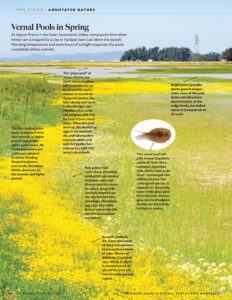We are now well into California’s “fifth season,” when the true aridity of our region most expresses itself and there’s no immediate hope of rain, though the coast is often lost in fog. This time of year is to a large extent floristically quiet, as befits a Mediterranean climate. Yet you may find, while wandering the fields in mid- to late summer, an ebullience of daisy-like yellow or white blossoms seemingly defiant of the strictures of summer. These are the tarweeds, also called tarplants.
Both names refer to the tarry exudate that coats pant legs and livestock that brush against the plant, and also to the compelling tar-like fragrance: pungent, soapy, with an intriguing undertone of kerosene. There are nearly 100 species of tarweeds in California, most of them restricted to the state. Mostly annuals, some are white, some yellow, or yellow with orange blotches; some are tall, some short, slender, or stout. Some are rare, some common. They can open in the morning and close at noon, or close in the morning and open at noon. Their odors are variously described as fragrant, mild, strong, ill-scented, or strongly ill-scented.
These differences notwithstanding, most tarweeds share drought-evading strategies that allow them to blossom in summer when the soil dries and cracks, days are long, and rain only a distant memory. Deeper-rooted than most annuals, tarweeds tend to grow in clay soils that may retain moisture at depth. Tarweeds also possess an unusual mucilaginous substance in the leaf tissue that helps them retain water. The tarry exudate discourages herbivory; indeed, cattle relish the plant when it’s young, but not when it’s mature and fully “tarry.” Some ranchers, not members of the Tarweed Appreciation Society, consider it a pest and try to eradicate it.
Earlier residents of California saw things differently. In Grace Carpenter Hudson’s painting The Tarweed Gatherer, a Pomo woman carries a seed beater and gathering basket used to harvest tarweed seed. For indigenous Californians, the beauty of wildflowers was literally mouthwatering, promising a bountiful seed harvest from which to make pinole (roasted, ground seeds of both forbs and grasses). Tarweed, with rich and oily seeds, was a star of the pinole panoply.
All along the West Coast, Native Americans fostered “seed pastures” through gathering and burning. One Oregonian writer from the early 1900s referred to tarweed as “wild wheat,” saying that the Indian’s autumn begins when “the le-mo-lo sap-o-lil (wild wheat or tarweed) had all been gathered and winnowed and the whole countryside could now be baptized with fire.”
The petals of the widespread common tarweed, Madia elegans, yellow with just a hint of green, are fully open only at the beginning or end of the day inland, or on cloudy or foggy days along the coast. This moisture-retaining strategy gives a good reason to go out in the garden in moonlight.
Tarweed appeared every summer around my house for about 10 years, then bafflingly disappeared. After enduring a few tarweedless summers, we replanted. I can again wander a tarweed forest, inhaling its deep-summer-in-California smell, fresh and bracing.
By blooming in midsummer, tarweeds capitalize on a lack of competition for pollinators. I share my love of tarweed with a plenitude of insects. Once as I collected seed from the hayfield tarweed (Hemizonia congesta ssp. congesta) into a basket, I disrupted a bug paradise. From August to October, the small black seeds, beloved by finches, rest in the dried flower heads, the stalks forming a delicate gray tracery. The fine blur of their crisp stems, holding on through the fall, is quite garden-worthy, especially when they are planted in masses at least ten feet square. Studies suggest pollinators prefer that to smaller, scattered populations–one of many examples where good garden design creates good habitat.
Deep in the dense coastal fogs of August, I see in the garden outside my study window a multitude of sunny yellow disks floating disembodied in the pervasive gray. Their stems and petioles are scarcely visible, so that the blossoms, with no visible means of support, seem suspended in midair. To say they are a cheering sight doesn’t begin to express the impact of tarweed blooming in the dry heart of our fifth season.

.jpg)



